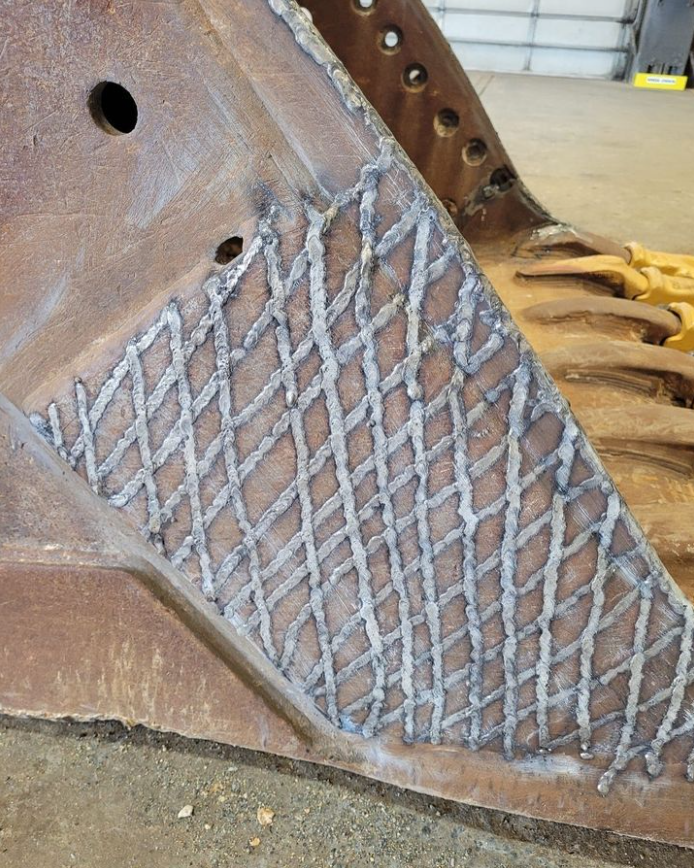Hardfacing welding is the process of applying a hard and wear-resistant material onto a metal surface to extend its service life. This process is commonly used in industries such as mining, construction, agriculture, and oil and gas.
The success of the hardfacing process depends on choosing the most suitable hardfacing consumables in terms of chemical composition, microstructure, and wear resistance for a particular application. So, the wear types and service conditions to which parts are exposed shall be well understood before choosing hardfacing consumables.
The Canadian welding market is expected to grow steadily in the coming years, driven by the growth in the construction and mining industries. The demand for hardfacing
welding is expected to increase as these industries require equipment and machinery that can withstand heavy use and wear.
Type of Wear
- Corrosion: Corrosion is often defined as the degradation of a metal by a chemical or electrochemical reaction with its environment.
- Build up: Severely worn areas can be rebuilt close to working size dimensions using tough,crack-resistant welding materials which can be deposited in an unlimited number of layers.
- Metal-to-Metal Friction: Wear from steel parts rolling or sliding against each other with little or no lubrication.
- Severe Impact: Wear from severe pounding which tends to squash, gouge and crack the surface.
- Abrasion Plus Impact: Wear from gritty material accompanied by heavy pounding which tends to chip or crack, as well as grind, away the
- Severe Abrasion: Wear from gritty materials which grind or erode the Severe abrasion is often accompanied by heavy compression or impact.
- Metal-to-Earth Abrasion: Wear from soil or aggregate materialsaccompanied by moderate impact.
Type of Applications
- Mining & Construction
- Shipbuilding
- Agriculture & Food industries
- Defence
- Oil & Gas
- Energy
- Transport
- Steel & Cement industries
Type of Hardfacing Welding Process
- Manual Metal Arc Welding(MMA)
- Gas Tungsten Arc Welding(GTAW).
- Gas Metal Arc Welding(GMAW)
- Plasma Transferred Arc Welding(PTAW)
- Submerged Arc Welding(SAW)
- Electroslag Welding(ESW)

Rockmount Alloys: The Specialist
Rockmount’s experience and quality make them the perfect partner for supplying all kinds of exotic consumables, and here are some examples of their hardfacing application consumables.
● APOLLO A - SMAW
Application: For joining, build-up and wear surfacing of all low alloy, manganese, medium and high carbon steels.
Strength: 135,000psi Shock and Abrasion Resistant
Usage: For build-up or wear facing where heavy impact and compression coupled with abrasion is required. Great for crushers, rail components, and heavy impact applications.
● APOLLO B - SMAW
Application: For joining dissimilar steels and for build-up or hard surfacing.
Strength: 105,000psi Resistant To Severe Impact
Usage: Joining wedge bars to dipper teeth, repairing cracked crusher rolls, surfacing valve seats, and welding alloy steel lips to manganese buckets.
● OLYMPIA - SMAW
Application: For build up and hard facing carbon, low alloy high manganese steels & cast iron.
Hardness: 52-54 RC Good Impact Resistance
Usage: A universal hard surfacing alloy which produces a self-hardening deposit that resists both severe abrasion and impact and best suited for crusher rolls, hammers, cutter heads, shovel buckets and teeth, pump housings and impellers.
● OMEGA N - SMAW
Application: For hard facing all ferrous metals with excellent abrasion resistance under impact. Deposits are ultra-smooth and provide a low friction surface.
Hardness: 60-62 RC Excellent Abrasion Resistance
Usage: Hardfacing where low friction, long wearing deposits with easy running and no spatter.
● ZETA C - SMAW
Application: Hardfacing for extreme abrasion even when accompanied with impact.
Hardness: 58 - 62 RC Super fast deposit rates up to 10 lb/hr.
Usage: Pump Castings & Impellers, Crushing Equipment, Brick Manufacturing Equipment, Suction Dredge Cutters, Railway Ballast Tampers, Dragline Buckets and Teeth, Earth Moving Equipment.
● ORION Flux Core
Application: Hardfacing for extreme abrasion resistance on carbon steels, alloy steels, cast iron and manganese steels.
Hardness: 60-65 RC Excellent hardness and abrasion resistance
Usage: Orion Flux Core has a 90% efficiency rate, producing very hard deposits quickly. It is exceptionally smooth running, getting the job done quickly with a high yield of material on the workpiece.
● ZETA Flux Core
Application: Hardfacing of high abrasion applications with heavy impact.
Hardness: 55-60 RC Corrosion Resistant
Usage: Zeta Flux Core will give excellent results on a wide range of hardfacing applications with high chrome deposits, resist stress cracking on chutes, buckets, ground engaging tools, crusher parts and skids.
Maintenance Welding Situations
On contaminated metals: Weld, rust, dirt, and oil all build up over time and the welder often can’t clean the base metal the way they would
Out of position: Maintenance welds are often made in hard to reach places.
On unidentifiable or dissimilar metals: Base metals can vary widely although they look the same.
With less experience: While most maintenance welders are highly skilled, they commonly weld on something they have never seen before, in situations they have never been in before.
Rockmount’s Hero products
- Brutus is designed to weld any steel including stainless, and is ideal for repairing unidentifiable or dissimilar metals. Brutus can also be used to extract broken bolts.
- Tartan products will easily weld out of position through oil, rust and dirt and work great on galvanized metals. They also strike incredibly well making them ideal for all levels of
- Polaris products produce both strong and ductile welds on contaminated steels making it ideal for repairing cracks in heavy equipment.
Market Analysis
The global hardfacing welding wires market was valued at US$ 361.52 million in 2022 and is expected to reach US$ 563.6 million by 2028. The North American market contributes 22% of the total business, which is expected to grow vigorously in the future, which shows how prominent the hardfacing business will be.


